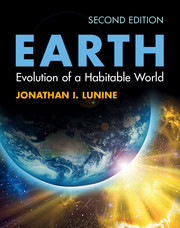Description
Earth (2nd Ed., Revised edition)
Evolution of a Habitable World
Author: Lunine Jonathan I.
Fully updated, this new edition provides a uniquely interdisciplinary overview of Earth's history and evolution for Earth science undergraduates.
Language: English
Subjects for Earth:
Approximative price 68.67 €
In Print (Delivery period: 14 days).
Add to cart
Publication date: 04-2013
327 p. · 21.5x27.3 cm · Paperback
327 p. · 21.5x27.3 cm · Paperback
Description
/li>Contents
/li>Biography
/li>
Fully updated throughout, including revised illustrations and new images from NASA missions, this new edition provides an overview of Earth's history from a planetary science perspective for Earth science undergraduates. Earth's evolution is described in the context of what we know about other planets and the cosmos at large, from the origin of the cosmos to the processes that shape planetary environments and from the origins of life to the inner workings of cells. Astronomy, Earth science, planetary science and astrobiology are integrated to give students the whole picture of how the Earth has come to its present state and an understanding of the relationship between key ideas in different fields. The book presents concepts in nontechnical language and mathematical treatments are avoided where possible. New end-of-chapter summaries and questions allow students to check their understanding and critical thinking is emphasized to encourage students to explore ideas scientifically for themselves.
Preface; Acknowledgements; Part I. The Astronomical Planet: 1. An introductory tour of Earth's cosmic neighbourhood; 2. Largest and smallest scales; 3. Forces and energy; 4. Fusion, fission, sunlight, and element formation; Part II. The Measurable Planet: Tools to Discern the History of Earth and the Planets: 5. Determination of cosmic and terrestrial ages; 6. Other uses of isotopes for Earth history; 7. Relative age dating of cosmic and terrestrial events: the cratering record; 8. Relative age dating of terrestrial events: geologic layering and geologic time; 9. Plate tectonics: an introduction to the process; Part III. The Historical Planet: Earth and Solar System through Time: 10. Formation of the solar system; 11. The Hadean Earth; 12. The Archean eon and the origin of life: i. Properties of and sites for life; 13. The Archean eon and the origin of life: ii. Mechanisms; 14. The first greenhouse crisis: the faint early sun; 15. Climate histories of Mars and Venus, and the habitability of planets; 16. Earth in transition: from the Archean to the Proterozoic; 17. The oxygen revolution; 18. The Phanerozoic: flowering and extinction of complex life; 19. Climate change across the Phanerozoic; 20. Toward the age of humankind; Part IV. The Once and Future Planet: 21. Climate change over the past 100,000 years; 22. Human-induced global warming; 23. Limited resources: the human dilemma; 24. Coda: the once and future Earth; References; Index.
Jonathan I. Lunine is the David C. Duncan Professor in the Physical Sciences at Cornell University. His research interests center broadly on planetary origin and evolution, in our solar system and around other stars. He works as an interdisciplinary scientist on the Cassini mission to Saturn and on the James Webb Space Telescope, and is also a co-investigator on the Juno mission which launched for Jupiter in August 2011. Dr Lunine is the author of over 230 scientific papers and besides the first edition of this book (Cambridge University Press, 1999), he has also written Astrobiology: A Multidisciplinary Approach (Pearson Addison-Wesley, 2005). He is a member of the US National Academy of Sciences and a fellow of the American Association for the Advancement of Science and the American Geophysical Union.
© 2024 LAVOISIER S.A.S.




